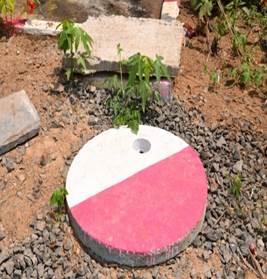Ministry of Jal Shakti
100% Saturation of Grey Water Management in Pappankuzhi Village, Tamil Nadu
प्रविष्टि तिथि:
15 JUL 2022 4:47PM by PIB Delhi
Success Story
Owing to the concerted efforts of community members and government officials, a grey water management system has been successfully implemented in Pappankuzhi Village Panchayat in Kanchipuram district of Tamil Nadu. The system which includes individual household soak pits and community soak pits with either horizonal or vertical type filter, effectively treats about 42,000 litres of greywater that is generated per day in the village. The initiative is a part of the Swachh Bharat Mission Grameen (SBM-G) Phase II campaign of which greywater management is an integral component.
Community leadership: It was Swachhagrahi, Ms. A. Sarla Devi who played a crucial role in creating awareness about the importance of solid and liquid waste management, highlighting the need for grey water management in the village. People were made aware of what grey water constituted and the hazards of improper management of grey water. Thereafter, President of the village, Mr. Ganesan and the Panchayat Secretary played a vital role in advocating the need for greywater management and allocated the necessary funds to establish a system in Pappankuzhi in November 2021. While the Panchayat took care of the operation and maintenance of the system, the community was encouraged to follow certain precautions to ensure better management. This included ensuring that waste was not dumped into the drainage channel; desilting was carried out to prevent stagnation of grey water and cleaning of the storm water drain on a regular basis.

Background of village: Situated in the Sriperumbudur block of Kanchipuram district, Pappankuzhi is made up of two habitations namely, Pappankuzhi village and Pappankuzhi colony with a total population of 1016 from 474 households. There are two overhead tanks in the village with a capacity of 30,000 litres each. Every day, about 60,000 litres of water is consumed by the households of which 70 per cent becomes grey water that amounts to about 42,000 litres per day.
Earlier, in the absence of such a system, it was common to see grey water being discharged onto the roads leading to pollution and stagnant water, the latter a breeding ground for mosquitoes, microbes and parasites that led to diseases such as Dengue, Malaria and Cholera. To make matters worse, there was open dumping and discharge into water bodies which contaminated both the surface and groundwater in areas with a high-water table. The community was also unaware that treated greywater could be used to provide relief from acute water stress.
What is Greywater: Greywater is the category of waste water that is not contaminated with faecal matter or urine. This includes used water from bathing, washing dishes, laundry, etc.
Soak pit models adopted for effective GWM: Individual household soak pits which are suitable for managing grey water at individual household level were constructed in 93 households at a cost of Rs. 9300 each. Further, 2 community soak pits with horizontal type filter were constructed at disposal points of drainage systems at a cost of Rs. 1,33,000 each. Such soak pits are suitable for clusters with high groundwater table and the treated water can be used for agriculture purposes. Additionally, one community soak pit with a vertical type filter which is suitable for clusters with low water table was constructed at a disposal point of the drainage system at a cost of Rs.127,000.


Individual household soak pits are simple to construct with locally available materials. Under this system greywater can be treated at source, preventing the flow of greywater onto the village paths, open land or stagnating in low lying areas. In Pappankuzhi village, 93 households could not be connected to the drainage channel and hence were provided with individual household soak pits to manage grey water.
Components of an individual household soak pit include a collection pipe or platform where greywater generated in households is collected; an inspection chamber where solid and other floating material suspended in the greywater get filtered; and the soak pit that consists of a concrete tub that is placed within where suspended particles settle, allowing greywater to overflow into the filter media where it gets filtered and safely percolates into the ground.
Community Soak Pits with horizontal and vertical type filters: Both the Horizontal and Vertical type filter soak pits are efficient for treatment of grey water generated from households that have space constraints. They are usually constructed at the discharge points of the drainage systems.
Drainage systems have been built in Pappankuzhi Village up to the grey water disposal point. Given that horizontal type soak pits are suitable for places with high water table where the treated water can be recovered and reused for agricultural activities; two such soak pits were constructed in Pappankuzhi village.
On the other hand, vertical type soak pits require less land area when compared to horizontal type soak pits and can be constructed in areas with low water table, where the treated water will help replenish the ground water table. Pappankuzhi has one vertical soak pit that was constructed near the Sivan Koil Street at a cost of Rs. 1,27,000.
******
BY
(रिलीज़ आईडी: 1841784)
आगंतुक पटल : 3604